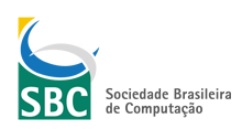An Agent-Based Model for Normative Hierarchical Organizations considering Goal Decomposition Process
Resumo
The ideas about the structures and interactions that happen in human organizations have been used to model agent-based normative hierarchical organizations. Some works have used social control to regulate the agents’ behavior to achieve an organizational goal, i.e., that is decomposed in a set of meaningful sub goals to the agents. Many organizational models have been defined to model these organizations, but they do not relate, more specifically, the agents in the hierarchical structure with the sub goals resulting from the decomposition process. This paper proposes an approach to bridge this gap, i.e., to model agent-based normative hierarchical organizations along with the goal decomposition process. In short, we extended a model found in Literature considering the goal decomposition defined in Moise+. We used UML diagrams to illustrate our extension.Referências
Boella, G., van der Torre, L., and Verhagen, H. (2006). Introduction to normative multiagent systems. Computational & Mathematical Organization Theory, 12(2):71–79.
Chiavenato, I. (2005). Teoría Neoclássica da Administração. In: Introdução à Teoría Geral da Administração. São Paulo: Campus.
Dignum, V. (2003). A model for organizational interaction: based on agents, founded in logic. PhD thesis, Utrecht University.
Ferber, J. and Gutknecht, O. (1998). A meta-model for the analysis and design of organizations in multiagent systems. In Proceedings of the Third International Conference on Multiagent Systems, ICMAS 1998, Paris, France, July 3-7, 1998, pages 128–135.
Ferber, J., Gutknecht, O., and Michel, F. (2004). From Agents to Organizations: An Organizational View of Multi-Agent Systems, pages 214–230. Springer Berlin Heidelberg, Berlin, Heidelberg.
Ferber, J., Stratulat, T., and Tranier, J. (2009). Towards an Integral Approach of Organizations in Multi-Agent Systems. In Dignum, V., editor, Handbook of Research on Multi-Agent Systems: Semantics and Dynamics of Organizational Models, pages 51–75. IGI Global.
Fox, M. S. (1979). Organization structuring: Designing large complex software. Computer Science Technical Report CMU-CS-79-155, Carnegie-Mellon University.
Horling, B. and Lesser, V. (2005). A survey of multi-agent organizational paradigms. The Knowledge Engineering Review, pages 281–316.
Hübner, J. F., Sichman, J. S., and Boissier, O. (2002). A Model for the Structural, Functional, and Deontic Specification of Organizations in Multiagent Systems, pages 118–128. Springer, Berlin, Heidelberg.
Isern, D., Sánchez, D., and Moreno, A. (2011). Organizational structures supported by agent-oriented methodologies. J. Syst. Softw., 84(2):169–184.
López y López, F. and Luck, M. (2004). A Model of Normative Multi-agent Systems and Dynamic Relationships, pages 259–280. Springer, Berlin, Heidelberg.
López y López, F., Luck, M., and d’Inverno, M. (2005). A normative framework for agent-based systems. In Symposium on Normative Multi-Agent Systems, NORMAS 2005, part of the SSAISB 2005 Convention, University of Hertfordshire, Hatfield, UK, 12-15 April 2005. Proceedings, pages 24–35.
OMG (2017). OMG Unified Modeling Language (OMG UML), Version 2.5.
Vázquez, L. E. M. and López y López, F. (2007). An Agent-Based Model for Hierarchical Organizations, pages 194–211. Springer, Berlin, Heidelberg.
Chiavenato, I. (2005). Teoría Neoclássica da Administração. In: Introdução à Teoría Geral da Administração. São Paulo: Campus.
Dignum, V. (2003). A model for organizational interaction: based on agents, founded in logic. PhD thesis, Utrecht University.
Ferber, J. and Gutknecht, O. (1998). A meta-model for the analysis and design of organizations in multiagent systems. In Proceedings of the Third International Conference on Multiagent Systems, ICMAS 1998, Paris, France, July 3-7, 1998, pages 128–135.
Ferber, J., Gutknecht, O., and Michel, F. (2004). From Agents to Organizations: An Organizational View of Multi-Agent Systems, pages 214–230. Springer Berlin Heidelberg, Berlin, Heidelberg.
Ferber, J., Stratulat, T., and Tranier, J. (2009). Towards an Integral Approach of Organizations in Multi-Agent Systems. In Dignum, V., editor, Handbook of Research on Multi-Agent Systems: Semantics and Dynamics of Organizational Models, pages 51–75. IGI Global.
Fox, M. S. (1979). Organization structuring: Designing large complex software. Computer Science Technical Report CMU-CS-79-155, Carnegie-Mellon University.
Horling, B. and Lesser, V. (2005). A survey of multi-agent organizational paradigms. The Knowledge Engineering Review, pages 281–316.
Hübner, J. F., Sichman, J. S., and Boissier, O. (2002). A Model for the Structural, Functional, and Deontic Specification of Organizations in Multiagent Systems, pages 118–128. Springer, Berlin, Heidelberg.
Isern, D., Sánchez, D., and Moreno, A. (2011). Organizational structures supported by agent-oriented methodologies. J. Syst. Softw., 84(2):169–184.
López y López, F. and Luck, M. (2004). A Model of Normative Multi-agent Systems and Dynamic Relationships, pages 259–280. Springer, Berlin, Heidelberg.
López y López, F., Luck, M., and d’Inverno, M. (2005). A normative framework for agent-based systems. In Symposium on Normative Multi-Agent Systems, NORMAS 2005, part of the SSAISB 2005 Convention, University of Hertfordshire, Hatfield, UK, 12-15 April 2005. Proceedings, pages 24–35.
OMG (2017). OMG Unified Modeling Language (OMG UML), Version 2.5.
Vázquez, L. E. M. and López y López, F. (2007). An Agent-Based Model for Hierarchical Organizations, pages 194–211. Springer, Berlin, Heidelberg.
Publicado
02/05/2018
Como Citar
FREIRE, Emmanuel S. S.; R. JR, Robert M.; CORTÉS, Mariela I.; CAMPOS, Gustavo A. L..
An Agent-Based Model for Normative Hierarchical Organizations considering Goal Decomposition Process. In: WORKSHOP-ESCOLA DE SISTEMAS DE AGENTES, SEUS AMBIENTES E APLICAÇÕES (WESAAC), 12. , 2018, Fortaleza/CE.
Anais [...].
Porto Alegre: Sociedade Brasileira de Computação,
2018
.
p. 37-48.
ISSN 2326-5434.
DOI: https://doi.org/10.5753/wesaac.2018.33253.



